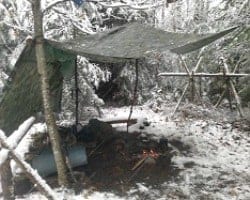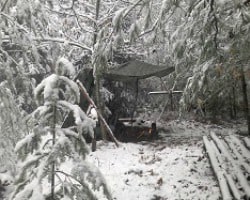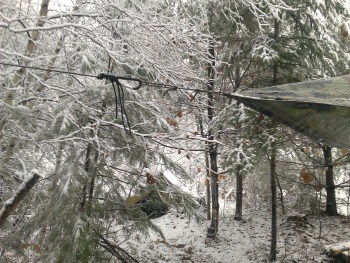I’ve always been a pretty big fan of sleeping under a tarp with the moon and the stars tucking me into sleep. In fact there is no occasion where I go into the bush without a tarp in my pack even when I do have a tent to slumber in. The versatility of this piece of kit makes it an absolutely indispensable survival item for your bug out bag. Yes, it is a shelter, but the humble survival tarp is also useful for the collection of water, hauling loads, fabricating a stretcher, rain gear or as a groundsheet.
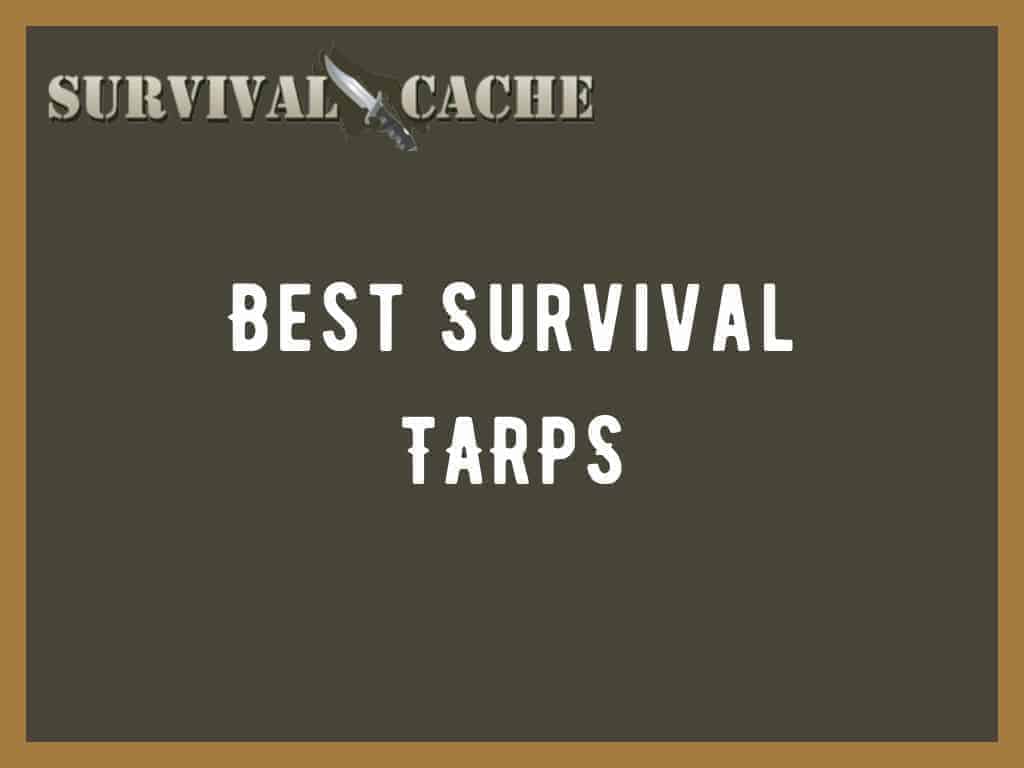
The versatility of the tarp is second only to the versatility of the number of shelter configurations that you can pitch with it.
When selecting a survival tarp there are several factors that must be taken into consideration before clicking ‘add to cart’. At a quick glance, here are our top picks:
| TARPS | DETAILS | ||
|---|---|---|---|

#1 Survival Tarp
|
|
Check Price on Amazon.com
|
|

|
|
Check Price on Amazon.com
|
|

|
|
Check Price on Amazon.com
|
SKIP AHEAD
What to Look For In A Survival Tarp: Buyer’s Guide
Size and Shape
I am a big fan of square tarps because of the number of the shelter configurations that a square tarp can provide. For shelter purposes an 8’ x 8’ tarp should be considered to be a bare minimum for an individual to stay comfortable and dry. I prefer to utilize a 10’ x 10’ tarp which provides ample room for not only myself and my gear, but has allowed me to sleep soundly through a thunderstorm while staying warm and dry. Rectangular tarps are a fine option but I find that they are limited to only a few different pitches but are great for a basic lean to or a classic A frame.
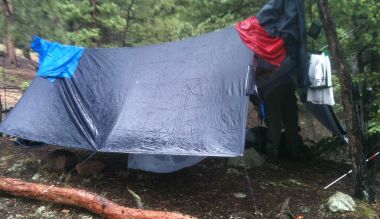
Depending on how many people are in your group you may want to choose a larger tarp but there will be a weight penalty and larger tarp shelters carry with it a higher degree of difficultly to pitch.
Durability
If your tarp is going to get a lot of use then the durability of the materials is going to be very important. Think about what the most likely use of this tarp is going to be and then check the customer reviews before buying. If your tarp is going to be the do-it-all workhorse, then you need one that is exceptionally durable and probably will be heavier and thicker. Whereas if your tarp is going to be strictly for shelter and nothing else then a reduction in durability for the savings in weight might be a good choice.
Weight
Tarps are lighter than tents but some tarps are lighter than others. Depending on the application the weight of your tarp can be a definite factor in your decision. For instance, if choosing a tarp for a bug out bag or day pack, size and weight would be a consideration. If you are planning on using these tarps instead of a tent then taking a bit of a weight penalty to have a larger and more durable tarp may be the way to go.
Tie outs or Grommets
Full disclaimer, I hate grommets with a passion. To me grommets are just these metal rings that are just laying in wait ready to tear out the corner of your nice new tarp the first time the wind picks up a bit. Tie out loops however, are the best and most secure way to tie out your tarp, just make sure that the areas that have the loops are sufficiently reinforced.
When it comes to tie outs it is very useful to have them on the centre seam as well especially for attaching a line to lift the centre of the tarp shelter to provide more head room. Making sure to have a lot of tie outs around the perimeter of the tarp will help you in being able to utilize a wider variety of pitches.
Waterproof
This one goes without saying but if your tarp has a seam then it has the potential to leak. Before taking a survival tarp into the field be sure to test it out with the garden hose and address any leaks that you might find. Most tarps come with a coating to the waterproof the material but these coatings can and will wear with time and abuse. If you care for your tarp though you can expect many years of rain shedding ahead.
Now that you know what to look for here are my top picks.
Best Suvival Tarps: My Top 5 Picks for Tarp Shelter
1. Best Survival Tarp (Overall) – Aqua Quest Safari Tarp Review
Aqua Quest is a well known brand name when it comes to tarps and it is an easy decision to have it top my list. This particular model of tarp comes in a variety of sizes and in both olive drab and camouflage colour scheme. The 10’ x 10’ version comes with 19 tie outs, 6 Boa straps and 6 stakes along with a stuff sack to put it all in. The Boa straps are an interesting feature, instead of a length of guy line these are nylon straps with adjustable tension. Maybe I’m old fashioned but I’m not totally sold on these Boa straps being superior to my usual paracord and truckers hitch setup.
Features
- Available in 10’ x 7’, 10’ x 10’, 10’ x 13’, and 20’ x 13’
- 70D Nylon fabric
- Depending on the size there can be between 15 to 25 tie outs
- Comes with Boa straps, stakes and a stuff sack
- Boa straps are 4’ long and have adjustable tension
- 10’ x 10’ packed size 12” x 5” x 3” Compresses down to 6” x 6” x 4”
- Lifetime warranty
Pros
- The 10’ x 10’ version weighs only 1.6 pounds
- Plenty of tie outs and no grommets
- Comes with enough straps and stakes to pitch a wide variety of shelter configurations
Cons
- Does not have the snaps the Snugpak does
- Boa straps may not hold the versatility of traditional guy lines or paracord

#1 Survival Tarp
|
|
Check Price on Amazon.com
|
2. Runner Up – Snugpak All Weather Shelter Review
The Snugpak All Weather Shelter is a great survival tarp option by a company that is know for producing high quality gear. Even though this tarp has the dreaded grommets the good people at Snugpak threw me a bone and also included tie outs alongside the grommets. This 2.2 pound 10 x 10 tarp comes with a nice zippered case, 4 ten foot guy lines and 8 tent stakes. Only coming in one size option is a bit of a negative but the 10’ x 10’ tarp is a great option for one or two people to sleep comfortably underneath. The one feature that caught my eye was the snaps that are included along opposite edges of the tarp to allow it to turn into a bivvi, which may not matter for most people but for those of use who don’t mind wrapping up in a tarp on the ground the addition of these snaps is a definite bonus.
Features
- 10’ x 10’ 210T Rip Stop Nylon
- 4 ten foot guy lines
- 8 tent stakes
- Olive drab
- 2.2 pounds
- Packed size 8” x 8” x 3” in a zippered case
Pros
- Snaps along opposite edges that turn the tarp into a bivvi
- Lots of tie outs
- Lightweight
- Comes with guy lines, stakes, and a case
Cons
- Only one size available
- Has grommets

|
|
Check Price on Amazon.com
|
3. Best Lightweight Tarp for Bug Out Bag – Aqua Quest Guide Tarp Review
This is the ultralight version of the Aqua Quest Safari and Defender traps. With the 10’ x 10’ option weighing in a 1.2 pounds and able to be compressed down to a tiny 6.25” x 6” x 4.5”, this is a fantastic option for your bug out bag especially if you want to forgo the tent as a shelter option. With the Boa straps, stakes and stuff sack this is the complete tarp shelter package. My only concern with a setup like this is the durability of such lightweight and thin material, but if you are cautious and mindful of how a lightweight tarp like this is handled then it should be manageable.
Features
- Available in 10’ x 7’, 10’ x 10’, 10’ x 13’, and 20’ x 13’ options
- 40D Rip Stop fabric
- Comes with Boa straps, stakes and stuff sack
- Between 13 and 21 tie outs depending on size of tarp
- 10’ x 10’ packed size 11.5” x 4.5” x 3” Compresses to 6.25” x 6” x 4.5”
- Lifetime warranty
Pros
- 10’ x 10’ version only weighs 1.2 pounds
- Plenty of tie outs
- Straps and stakes can be used to pitch a wide variety of tarp configurations
Cons
- Lightweight and thin material may lack durability

|
|
Check Price on Amazon.com
|
4. Best Survival Tarp for Day Pack – S.O.L Survive Outdoors Longer Utility Blanket Review
This is a tarp that is always in my hiking day pack and I’ve set it up in a couple of configurations on a few occasions, and for an emergency shelter it’s pretty damned good. I would not hesitate to spend a night underneath one of these which is why it is always in my day pack with some aluminum stakes and a length of paracord. Weighing only 11.3 ounces and packing down to 13” x 7.8” x 2.5” you’ll hardly notice it is in your pack. The tarp itself is 5’ x 7’ which is not an ideal shape or size but can be pitched in a couple of good configurations. Unfortunately it has 6 grommets instead of tie outs and does not come with any guy lines or stakes. Another good feature is the reflective side that will reflect 95% of your body heat back to you. Overall though this is a good option for emergency shelter.
Features
- Orange on one side and reflective on the other which is claimed to reflect 95% of body heat
- 5’ x 7’ with 6 grommets
- Weighs only 11.3 ounces
- Packed size 13” x 7.8” x 2.5”
- Comes with resealable bag
Pros
- Lightweight
- Reflective side reflects 95% of body heat
- Resealable bag has room to store tent stakes and guy lines
Cons
- Grommet instead of tie outs
- No stakes or guy lines

|
|
Check Price on Amazon.com
|
5. Best Budget Survival Tarp – Chill Gorilla Review
For those of us who don’t have the budget for the Aqua Quests or Snugpaks, or want a functional decent tarp that they won’t feel the pain in the wallet if it gets lost or damaged, then the Chill Gorilla is a good option. This 1.4 pound 10’ x 10’ tarp is made from 210D Rip Stop Nylon and comes with 6 guy lines 4 stakes and a stuff sack to tote it around in. This tarp has multiple tie outs in the form of sewn in plastic D-rings which I’m not entirely comfortable with since I’ve seen far too many plastic rings break to trust these ones entirely.
Features
- 210D Rip Stop Nylon
- 10’ x 10’ tarp packs down to 12” x 4” in stuff sack
- Comes with guy lines and stakes
- D-Ring tie outs
- Weighs 1.4 pounds
Pros
- Lightweight
- Comes with guy lines and stakes
- Has centre tie out
Cons
- Plastic D-Ring tie outs may be susceptible to breakage like grommets
- Only one size option

|
|
Check Price on Amazon.com
|
FAQs about Survival Tarps
How should I care for a survival tarp?
First and foremost under no circumstances should you store any tarp wet. Always hang to dry before folding and storing in it’s stuff sack. When cleaning your tarp do not use abrasives, a soft brush and rag with mild detergent is more than sufficient to clean any dirt off your tarp. When storing a tarp or packing it into your bag try and avoid having any debris trapped between the folds when folding it up. Any debris or dirt will act as an abrasive and wear out your tarp far more rapidly.
Why are tie outs better than grommets?
Grommets are essentially a hole in the tarp reinforced with a metal ring. The problem with these is that the force of a rope or strap is pulling this metal ring into the already compromised material, and eventually may tear the grommet straight through the side of the tarp. Tie outs on the other hand are sewn into the fabric and on a good quality tarp, are reinforced with additional fabric over top. The pulling force on the tie out is distributed over the length of the area the tie out is sewn thus spreading out the load.
What advantages does a square tarp hold over a rectangular tarp?
Both shapes of tarp have their place and when erecting a shelter either will give you a bunch of pitch options. A square tarp however gives more shelter configurations over a rectangular tarp. From a simple plow point, to a more complex Adirondack there is an option for every situation where a rectangular tarp is more limited. Ultimately it comes down to personal preference as to which shape of tarp you decide to go with.
Is It a Good Idea to Put a Tarp Under a Tent?
It might not always be necessary to put a tarp down under your tent, but it is something that you can do if you want to create an extra layer of protection for your shelter.
When the tarp is used properly, it can work to protect your tent from punctures and reduce any mud and water seepage. However, most people tend to use a tarp that is too big for their tent, which can actually cause more problems than it is worth.
Whether or not you should put tarp down under your tent will depend on the tent you are using. Though, it can help to protect your tent from punctures and moisture. Another great benefit of adding tarp under your tent is that it will help to keep you warmer through the added layer of insulation.
Can You Put a Tarp Over a Campfire?
Yes, you can put a tarp over a campfire, as long as you do so safely. You should always make sure that you are elevating the tarp at a slight angle, with the highest corner of the tarp being directly over the fire, and the furthest end touching the ground.
This will ensure that the smoke will be able to escape. If you place the tarp flat over the fire, it probably isn’t going to last for very long.
To make sure that the tarp is high enough above the fire, you should place your hand above the fire, close to the tarp, to feel how hot it is.
The best type of tarp to use for this purpose is one that has been fire treated, but standard tarp will work fine if you do not have it available to you. Make sure that you never leave your fire unattended.
How Thick Should a Tarp Be Under a Tent?
It doesn’t actually matter how thick the tarp is underneath your tent as long as you have used the right sized tarp. The only thing that will influence how thick the tarp is would be damage.
Obviously, if the tarp is really thin, then it could split open on a rock on the ground and render it pretty much useless. Standard tarps should do the job, but you will need to make sure that it is the right size, otherwise it is not going to work.
Unfortunately, there is no tarp size that will work perfectly with every tent, but the general guideline is that you buy a tarp that is around 2-3 inches smaller than the actual outside dimensions of your tent.
This will help to ensure that you don’t face any issues with water pooling.
Do Tarps Block Heat?
A tarp will not always block out the heat, but the level of heat blocking will depend on the type of tarp that you are using.
Tarps are great for offering you protection from the sun and wind when you are out in the wild. If you are unable to find any shade, then you can use a tarp to get you out of the sun. You can string the tarp up between trees or poles for some instant shade to help protect you.
This will protect you from the harsh rays of the sun, but it will also keep the heat inside, which might not always be what you want.
Some of the best tarps to use for blocking out heat are those that are white or silver in color. These will offer you shade from the sun, but they will also reflect sunlight, rather than absorb it.
Are Tarps Breathable?
Not all types of tarp will be breathable, so it is important to know what you are buying. Some of the best tarps for breathability are canvas tarps, which are both strong, durable, and breathable.
You can get your hands on waterproof versions of this tarp, but something that you should be aware of is that not every canvas tarp will be waterproof, and many of them are only water resistant.
Unfortunately, this means that a small amount of water won’t make a difference, but they won’t be efficient if you are using them in really heavy rain. If the water cannot quickly drain away from a canvas tarp, then it will start to drip through the material.
If you want to purchase a canvas tarp for its breathability, you will need to check if it is waterproof first.
What Does Mil Mean in Tarps?
When it comes to choosing the right tarp for you, you should know that the term mil is referring to the actual thickness of the tarp. For general use, you can simply go for a tarp that is lightweight with a thickness of around 5 mils.
However, for more heavy-duty use, like camping, you are probably going to need a tarp that is more heavy-duty, with a thickness of at least 23 mils. This will ensure that it is more durable and long-lasting than other thinner types of tarp.
There are also lots of different materials to consider, like canvas, vinyl, poly, and mesh, and the definition of heavy-duty can vary between these materials.
Generally, a thickness of 12 mil is what will classify as heavy-duty, so the thicker the material the more durable it will be. You can even get tarps in excess of 50 mils.
Are Tarps UV Resistant?
Whether or not the tarp will be UV resistant will depend on the type of tarp that you are getting.
There are lots of different types of tarp that are UV resistant, and these are often the best types to get for the wilderness. We will leave some of the different UV resistant materials that you can get for tarps below.
Vinyl coated and vinyl laminated polyester tarps will be able to provide UV resistance, and they are also waterproof, highly durable, tear resistant, and mildew resistant. You can get these types of tarps in a variety of different weights, thicknesses, and colors.
Polyethylene tarps are both economical and lightweight, and they will also offer UV protection. As well as this, they are really strong, waterproof, and mildew resistant.
Mesh tarps are great for offering UV protection, but they are also great for providing excellent airflow to keep you cold when you are under them.
Easy Survival Tarp Shelter: How-To
By Jarhead Survivor, a contributing author of Survival Cache
There are a thousand ways you can make a shelter out of tarp. It’s a great piece of knowledge to have, so I’m going to show you an easy
Knowledge
It’s a great piece of knowledge to have, so I’m going to show you an easy system I came up with.
I ran a ridge pole between two trees then ran the tarp over it the long way. On each end I used paracord through the grommets tied to stakes or tree limbs that were readily available. The back of the shelter is about a foot off the ground, but I’ll probably either drop that in the winter or pile snow up to it. I wanted the top of the shelter a good distance from the flames so that it wouldn’t melt the tarp or catch it on fire. On one of the top corners I put a carabiner in the middle of the line so I can easily drop one side of the shelter when I leave, otherwise it would eventually tear or collapse under the weight of water or snow trapped on the tarp.
In the middle of the tarp I ran a small pine limb with the end flattened to hold the middle of the tarp up. This helps keep water and snow to run off, which helps to keep the tarp from collapsing. As I mentioned earlier there are hundreds of ways you can build a tarp shelter and you’re limited only by your imagination. I have a military poncho that I’ve used to make many a shelter, but the tarps are bigger and you can make a good-sized shelter for minimal dollars.
I like the darker colored or camo tarps too, because I hate things that stand out in the forest. Call it a remnant of my military background, but if I’m out camping in deep forest I like to blend in rather than stand out. I have included various pictures of what it looks like in the snow, the carbiner system I used, and a fire going under the shelter. In the video below, I talk about how I set it up and you can get a better idea of what it looks like.
Verdict
I really like the Aqua Quest tarps and they are great choices but Snugpak’s inclusion of the snaps to turn it into a bivvi was a feature that I personally really liked. If you are just looking for a high-quality lightweight survival tarp then go Aqua Quest, but if you’re like me and foresee a time when you are going to want to wrap yourself up in your survival tarp on the ground then the Snugpak is probably the better option.
As far as a straight up emergency survival tarp the SOL Sport Utility Blanket is the option I trust and never leave for a day hike without. I’ve put a ridge line with preinstalled prusik loops, a SOL emergency blanket, and four tent stakes into the resealable bag the tarp comes in making it a complete emergency shelter kit. The tarp was the first portable shelter option for humans and it remains a viable option today even with a wide variey of lightweight and great tent options. I personally love to wake up to the rising sun bathing me in a blanket of warm sunlight and the tarp is more often than not my go to shelter option.
| TARPS | DETAILS | ||
|---|---|---|---|

#1 Survival Tarp
|
|
Check Price on Amazon.com
|
|

|
|
Check Price on Amazon.com
|
|

|
|
Check Price on Amazon.com
|







